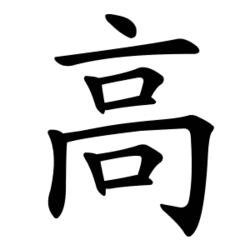Radical 189
| 高 | ||
|---|---|---|
| ||
| 高 (U+9AD8) "tall" | ||
| Pronunciations | ||
| Pinyin: | gāo | |
| Bopomofo: | ㄍㄠ | |
| Wade–Giles: | kao1 | |
| Cantonese Yale: | gou1 | |
| Jyutping: | gou1 | |
| Japanese Kana: | コウ kō (on'yomi) たか-い taka-i / たか taka / たか-まる taka-maru / たか-める taka-meru (kun'yomi) | |
| Sino-Korean: | 고 go | |
| Hán-Việt: | cao | |
| Names | ||
| Japanese name(s): | 高い/たかい takai | |
| Hangul: | 높을 nopeul | |
| Stroke order animation | ||
 | ||
Radical 189 or radical tall (高部) meaning "tall" is one of the 8 Kangxi radicals (214 radicals in total) composed of 10 strokes.
In the Kangxi Dictionary, there are 34 characters (out of 49,030) to be found under this radical.
高 is also the 191st indexing component in the Table of Indexing Chinese Character Components predominantly adopted by Simplified Chinese dictionaries published in mainland China.
Evolution
-
 Oracle bone script character
Oracle bone script character -
 Bronze script character
Bronze script character -
 Large seal script character
Large seal script character -
 Small seal script character
Small seal script character
Derived characters
| Strokes | Characters |
|---|---|
| +0 | 高 髙 (=高) |
| +4 | 髚 |
| +5 | 髛 |
| +8 | 髜 |
| +12 | 髝 |
| +13 | 髞 |
Sinogram
The radical is also used as an independent Chinese character. It is one of the Kyōiku kanji or Kanji taught in elementary school in Japan.[1] It is a second grade kanji.[1]
References
- ^ a b "The Kyoiku Kanji (教育漢字) - Kanshudo". www.kanshudo.com. Archived from the original on March 24, 2022. Retrieved 2023-05-06.
Literature
- Fazzioli, Edoardo (1987). Chinese calligraphy : from pictograph to ideogram : the history of 214 essential Chinese/Japanese characters. calligraphy by Rebecca Hon Ko. New York: Abbeville Press. ISBN 0-89659-774-1.
- Lunde, Ken (Jan 5, 2009). "Appendix J: Japanese Character Sets" (PDF). CJKV Information Processing: Chinese, Japanese, Korean & Vietnamese Computing (Second ed.). Sebastopol, Calif.: O'Reilly Media. ISBN 978-0-596-51447-1.
External links
Wikimedia Commons has media related to Radical 189.